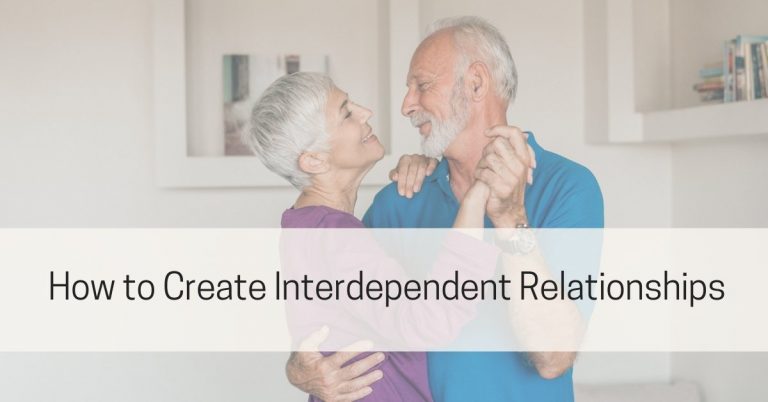
What is an interdependent relationship?
Humans are social beings; we’ve always craved connection and depended on each other for our survival. Relying on others for emotional and practical support is a natural part of the human experience. This is called interdependency.
In an interdependent relationship, people rely on each other for support and love—and also maintain their own sense of independence and self-esteem. Both people feel comfortable asking for what they need and offering what they can give. They are also able to respect each other’s boundaries and decisions.
Interdependence vs. Codependence
Codependency is an unhealthy form of dependency and often leads people to assume that all dependency is unhealthy. Let’s take a look at the difference between healthy dependency (interdependence) and unhealthy dependency (codependence).
Individuals with codependent tendencies often rely on others for their sense of identity and emotional well-being. They may struggle to distinguish their own needs and desires from those of their partner, leading to a sense of responsibility for the other person’s happiness and well-being. This enmeshed dynamic can often result in the codependent individual relying on others for validation and fulfillment.
Read more about codependent relationships.
Interdependent relationships are characterized by:
- Mutual respect: Interdependent partners respect each other’s opinions, values, and goals. They try to understand each other’s perspective but don’t have to agree on everything.
- Healthy communication: Interdependent partners communicate openly and honestly with each other. They can share their thoughts, feelings, and needs without fear of judgment.
- Clear boundaries: Interdependent partners have clear boundaries in place. They know what they are and aren’t willing to do for their partner, and they communicate those boundaries clearly.
- Individuality: Interdependent partners maintain their own sense of individuality. They have their own interests, hobbies, and friends outside of the relationship.
- Growth-oriented: Interdependent partners support each other’s goals, interests, and friendships; they don’t feel jealous or threatened by them. They want each other to grow, pursue their goals, and live authentically.
- Personal accountability: Interdependent partners take responsibility for their actions and make amends when they’ve hurt each other.
- Emotional safety: It feels safe to share your thoughts, feelings and needs, speak up, be yourself, take risks, and make mistakes.
Interdependent relationships make our lives fuller; they’re rooted in emotional safety, trust, and acceptance. Codependent relationships constrict us; they’re rooted in fear and insecurity.
Why it’s hard to create interdependent relationships
Creating interdependent relationships is challenging for a variety of reasons. Some of the most common reasons include:
- Childhood experiences: People who grew up in dysfunctional families or who experienced childhood trauma are more likely to develop codependent relationships. This is because they may have learned that they are only worthy of love and acceptance if they take care of others or if they are needed. In addition, dysfunctional families can necessitate becoming independent at a young age; you prioritize self-sufficiency, downplay your needs, and are reluctant to ask for help.
- Low self-esteem: People with low self-esteem may have a hard time trusting themselves and making decisions for themselves. They may also feel like they need to rely on others for approval and validation.
- Fear of abandonment: People who are afraid of being abandoned may cling to their partners too tightly. They may also have a hard time expressing their own needs and wants, for fear of being rejected.
- Cultural influences: Some cultures place a high value on selflessness and put the needs of others before their own. This can make it difficult for some to develop interdependent relationships.
How to create interdependent relationships
Now that you understand what an interdependent relationship is, let’s turn our attention to how to develop them.
- Get to know yourself: The first step to creating interdependent relationships is to get to know yourself. What are your values? What are your goals? What are your needs? Once you have a better understanding of yourself, you’re better able to communicate your priorities to others and can live more authentically.
Get to know yourself with The Self-Love Guided Journal.
- Value your individuality: It’s important to maintain or cultivate your own sense of individuality in an interdependent relationship. This means having your own interests, hobbies, and friends outside of the relationship. It also means being able to make your own decisions and stand up for what you believe in.
- Be supportive of each other’s goals and dreams: Encourage each other to pursue your passions and dreams. Celebrate each other’s successes.
- Share your feelings and needs: In an interdependent relationship, it’s safe to share your feelings and needs. Strive to communicate openly and honestly. And demonstrate interest in your partner’s feelings and needs, as well.
- Set boundaries: Boundaries tell others how we want to be treated. Communicate your expectations and limits clearly and assertively. Boundaries are also important because they define who you are as a separate, unique person; without them, you may revert to people-pleasing and give up who you are to please or appease others.
Read more about how to set boundaries.
- Be accountable: Take responsibility for your mistakes and admit when you’re wrong. If you harm your partner, acknowledge it, and take steps to make amends.
The most important thing to remember about interdependent relationships is that they’re safe. It’s safe to be your authentic self. It’s safe to pursue your goals and interests. It’s safe to have needs, feelings, and disagreements. It’s safe to set boundaries. And it’s safe to make mistakes.
As you take steps to create interdependent relationships, be patient. It doesn’t happen overnight. However, it’s worth the effort as interdependent relationships are more fulfilling and they’re more likely to last than codependent or one-sided relationships.
©2023 Dr. Sharon Martin, LCSW. All rights reserved. Photos courtesy of Canva.com.
Related Articles
Source:Dr. Sharon Martin , www.livewellwithsharonmartin.com, [publish_date
Source Link